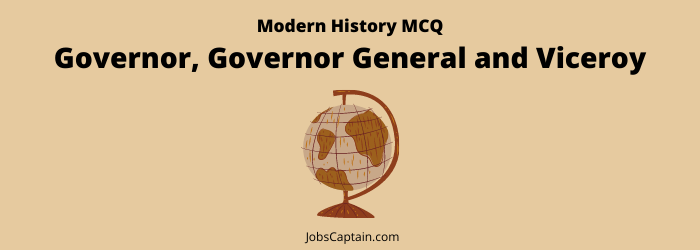
Question 1. ‘Ring Fence’ policy is associated with _________.
(A) Henry Lawrence
(B) Dalhousie
(C) Warren Hastings
(D) Lord Clive
Question 2. The policy of ‘Security cell’ is related with ___________.
(A) Warren Hastings
(B) Lord Dalhousie
(C) Henry Lawrence
(D) Lord Hastings
Question 3. At the time of the establishment of Asiatic Society in Calcutta, who was the Governor General of Bengal?
(A) Lord Cornwallis
(B) Lord Warren Hastings
(C) Lord Wellesley
(D) Lord Bentinck
Question 4. The first Governor-General of India was _________.
(A) Robert Clive
(B) Warren Hastings
(C) Lord Mayo
(D) Lord Dalhousie
Question 5. Which Governor-General was prosecuted for impeachment?
(A) Warren Hastings
(B) Lord Clive
(C) Lord Cornwallis
(D) Lord Wellesley
Question 6. Who among the following abolished ‘Dual Government’ system in Bengal?
(A) Robert Clive
(B) Lord Cornwallis
(C) Warren Hastings
(D) None of the above
Question 7. Who established the judicial organization in India?
(A) Lord Mayo
(B) Lord Cornwallis
(C) Lord Attlee
(D) Lord Curzon
Question 8. The transfer of capital of British India from Calcutta to Delhi was affected during the period of?
(A) Lord Minto
(B) Lord Hardinge
(C) Lord Chelmsford
(D) Lord Reading
Question 9. The enforcement of the Public Service was done in?
(A) Tenure of Bentinck
(B) Tenure of Cornwallis
(C) Tenure of Curzon
(D) Tenure of Dalhousie
Question 10. Who among the following Governor-Generals created the Covenanted Civil Service of India which later came to be known as the Indian Civil Service?
(A) Warren Hastings
(B) Wellesley
(C) Cornwallis
(D) William Bentinck
Question 11. Between whom was the ‘Treaty of Bassein’ signed in 1802?
(A) English and Bajirao I
(B) English and Bajirao II
(C) French and Bajirao I
(D) Dutch and Bajirao I
Question 12. The Tomb of Lord Cornwallis is situated at ________.
(A) Ghazipur
(B) Ballia
(C) Varanasi
(D) Gorakhpur
Question 13. Subsidiary Alliance was implemented during the reign of _________.
(A) Lord Cornwallis
(B) Lord Wellesley
(C) Sir John Shore
(D) Lord Auckland
Question 14. First Maratha Sardar to accept the subsidiary alliance of Lord Wellesley was _________.
(A) Peshwa Bajirao II
(B) Raghuji Bhosle
(C) Daulatrao Sindhia
(D) None of the above
Question 15. The first Indian ruler who joined the Subsidiary Alliance was __________.
(A) The Nawab of Awadh
(B) The Nizam of Hyderabad
(C) Peshwa Bajirao II
(D) The King of Travancore
Question 16. Who was the first Indian native ruler to accept the system of the subsidiary alliance?
(A) Sindhia of Gwalior
(B) Nizam of Hyderabad
(C) Dalip Singh of Punjab
(D) Gaikwad of Baroda
Question 17. Who introduced Subsidiary Alliance System in the administration to establish the British power over the Indian States?
(A) Warren Hastings
(B) Lord Wellesley
(C) Lord Cornwallis
(D) Lord Dalhousie
Question 18. The Subsidiary Alliance was not accepted by __________.
(A) The Nizam of Hyderabad
(B) The Holkar state of Indore
(C) The Rajput state of Jodhpur
(D) The Ruler of Mysore
Question 19. At the time when empires in Europe were crumbling before the might of Napoleon, which one of the following Governors-General kept the British flag flying high in India?
(A) Lord Dalhousie
(B) Lord Cornwallis
(C) Lord Wellesley
(D) Lord Hastings
Question 20. The main aim of East India Company to make subsidiary alliance in Rajput states was _________.
(A) Receiving military support against enemies
(B) Protecting these states from Maratha-Pindari invasion
(C) To receive funds in the form of Khiraj
(D) To establish the sovereignty of the British
Question 21. Anglo-Nepal War took place during the reign of __________.
(A) Lord Cornwallis
(B) Lord Hastings
(C) Lord Wellesley
(D) Warren Hastings
Question 22. The revolt of Vellore occur during the regime of which Governor?
(A) Wellesley
(B) Lord Minto
(C) Lord Cornwallis
(D) Sir George Barlow
Question 23. Which one of the following pairs is not correctly matched?
(A) Hector Munro – Battle of Buxar
(B) Lord Hastings – Anglo-Nepal War
(C) Lord Wellesley – Fourth AngloMysore War
(D) Lord Cornwallis – Third Anglo – Maratha War
Question 24. The Treaty of Sigauli took place in the year?
(A) 1800 A.D.
(B) 1803 A.D.
(C) 1805 A.D.
(D) 1816 A.D.
Question 25. Third Anglo-Maratha war is related to ___________.
(A) Sir John Shore
(B) Lord Wellesley
(C) Lord Hastings
(D) Lord Cornwallis
